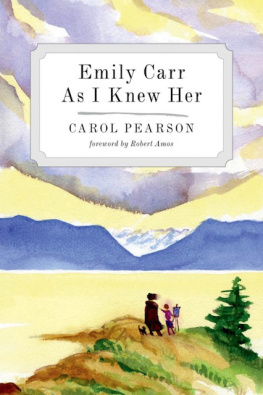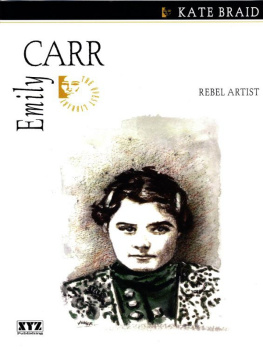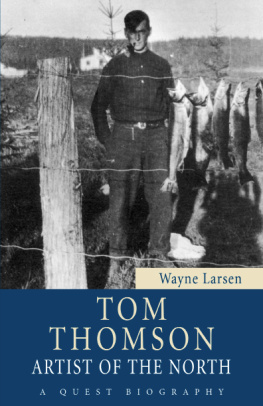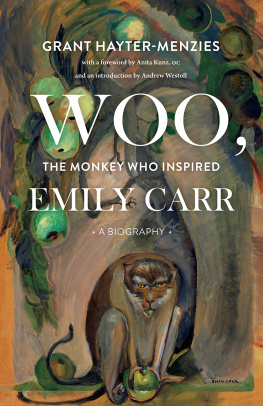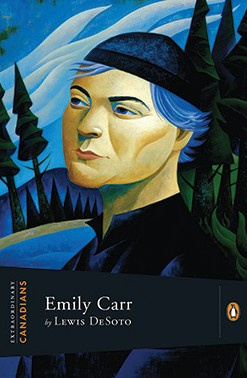Emily Carr
As I Knew Her
CAROL PEARSON
forewords by Robert Amos
and Kathleen Coburn
FOREWORD
The little room under the eaves! It was no wonder that this was her favourite or, as Miss Carr said, mostest favourite room! Yet every time I stayed with her, if only for a night, she would make it up fresh, and insist that I use it. The first two years after I met Miss Carr, she was my teacher, in art and modelling [in clay]. As our relationship developed, the teaching was only an incident. She was like a fairy Godmother, complete with animals, whom I loved completely, a childish worship if you like, but she returned my love. After the first year I was her guest from time to time, casually, but after two years she asked me to move right in, and the small room was then known as Baboos eyrie. She never used it again, after I left the West to be married. All things come home to roost, Baboo; it will be ready when you come, she said.
Carol Pearson, Emily Carr As I Knew Her , p. 144
ALL the scholarship and research that have accumulated since her time adds to our appreciation of Emily Carr, helps us understand her place in society and the messages she conveyed in words and pictures. But what was she really like? Thats what we want to know. And there is no better guide than Carol Pearson. Pearson was a child herself, and Carr was as an eternal child of wonder. Later, when Carrs painting days were past, her animals were all gone, and Carol had grown and married, she was there again with Emily Carr.
Emily Carr died in 1944, and it must have been soon after that time when Carol Pearson sat down to write her memoir of what had happened between them from 1920 and 1944. It was her first book, and a surprisingly good one it is. It seems she wrote it with Emily Carrs writing style as a guidenever use two words when you can say it in one, and never use a long word where a short one will do. The prose is effortless, and generous with the reader.
For many years, Emily Carr seemed to have lost the joy of life that was so evident in her stories in The Book of Small . Orphaned at sixteen years old, she didnt have the guidance and support of her parents while facing the emotional and economic struggles of a young artist. Her older sisters either ignored her ambition or tried to curb her efforts, believing that the life of an artist was not appropriate for someone of her social standing and God-fearing upbringing. Among the Victorians of the day, they were not alone in this attitude.
After a long struggle, when Carr was in her forties, she built her own little apartment building on Simcoe Street in 1913, the House of All Sorts of her later book. But as an income generator and as a refuge for an artist it was useless; she had no privacy and no time to paint. The economic realities of being a landlady put her in a position she did not enjoy. Those golden days of childhood were long gone.
Then little Carol moved to the neighbourhood with her parents. The best source of information about Carol Pearson (ne Williams) is Maria Tippetts book Emily Carr: A Biography (Oxford University Press, Toronto, 1979). Tippett, who interviewed Pearson and read her correspondence with Carr, says the Williams family moved from Toronto to Victoria around 1920. Carol was enrolled at Queen Margarets School in Duncan, where she boarded.
In the summers, when her parents returned to Ontario, she and her brother stayed in Victoria at Alice Carrs little school. Little Carol took art classes from Emily Carr, and the two found a deep and immediate sympathy. As Carr later told Ira Dilworth, it was love at first sight. In subsequent summers, Carol lived with Emily, sharing a friendship both innocent and profound, and Carr regained her joy of youth.
On her property on Simcoe Street, Carr had raised English sheepdogsbobtails. This was a commercial enterprise, and between 1917 and 1921, Carr raised more than 350 of these large dogs. When some of her property was sold, she turned her attention to the smaller griffon dogs. Emily and Carol shared a profound rapport with animals, and Carr taught her all she could about dogs.
They walked the dogs at Beacon Hill; they searched for clay at building sites and then worked on Carrs Klee Wyck pottery; they went on sketching expeditions up the east coast of the island, taken there by gas boat by First Nations elders. As Maria Tippett has written, Carol wanted to be an artist like Emily, who gave her painting lessons, often on the Dallas Road cliffs. Alongside her young pupil, Emily was herself spurred on to paint more.
Carol called Miss Carr Mom, and was called by her Baboo. Her concern in this book is not so much Carrs painting as her way with words and ideas, and the warmth of their loving relationship.
At age eighteen, Carol married William Pearson, and they moved to a horse farm north of Toronto. Miss Carr arrived to visit the newlyweds in 1927, at a key juncture in her artistic career. Carr had been discovered by Marius Barbeau of the National Museum in Ottawa. At the time, her paintingsand rugs and potterymade a striking centrepiece in his exhibit of native art and paintings of the West Coast, held in Ottawa, and at the Art Gallery of Toronto. Carr came east for the show. Her efforts were utterly vindicated, and at this time she met Lawren Harris and the Group of Seven. Between Ottawa and Toronto, she stayed with Carol, and returned again for subsequent visits with the Pearsons.
During her last years, when Carrs health was declining, Carol was summoned to the West, and Miss Carr sent her the tickets. Reading Carols book, Emily Carr As I Knew Her , enables you to accompany her as she pushes Miss Carr, warmly wrapped up and sitting in a wheelchair, as they return again to Dallas Road. The author shares her thoughts and feelings about the dogs, the monkey Woo, and the artist who was her friend. Carol was with Miss Carr almost to the end.
Do we need another book about Emily Carr? She herself provided more than enough information about her life and thoughts. Yet, perhaps for literary effect, she does not present herself in the best light. Since her death, all her journals, and even the outtakes from her journals, have come into print. But the extreme close-up of the self-portrait lacks the perspective a loving friend can bring.
Subsequently, others have written about Carr, a woman I consider Canadas most important artist. Edythe Hembroff came into Carrs life around 1930 after returning from her art education in San Francisco and London, which strangely paralleled Carrs own studies. Edythe accompanied Carr during her sketching trips around Victoria in the 1930s, and the word pictures she paints in her book M.E.: A Portrayal of Emily Carr (Clarke, Irwin & Company, Toronto, 1969) are invaluable. Later, in her book Emily Carr: The Untold Story (Hancock House, Saanich, 1978) Hembroff wrote that Carol was an affectionate friend of Emilys, but one should not forget that she is a fantasist who has written a shockingly untruthful book... I emphatically dispute the fairy tales she relates in her book about her very special secret relationship with Emily.
While the odd fact may be disputed, Hembroffs comments seem spurred by jealousy. In her biography, Maria Tippett commented, If Emily expected to find in her another Carol Williams, she was disappointed. Hembroff was older, she did not possess the childlike spontaneity... nor was she as passionately fond of Emilys creatures. Perhaps Hembroffs intemperate comments kept Carols book out of print for many years.
I discovered a tattered copy of the 1954 edition years ago and have read Carols book numerous times, both to myself and aloud to my painting companions at Mount St. Mary Hospital, where I conduct an art group. I found it utterly engaging, and asked TouchWood Editions to consider bringing it back for us. Once again we can share the best of all character studies of an artist each of us seems to knowin Carol Pearsons Emily Carr As I Knew Her .

